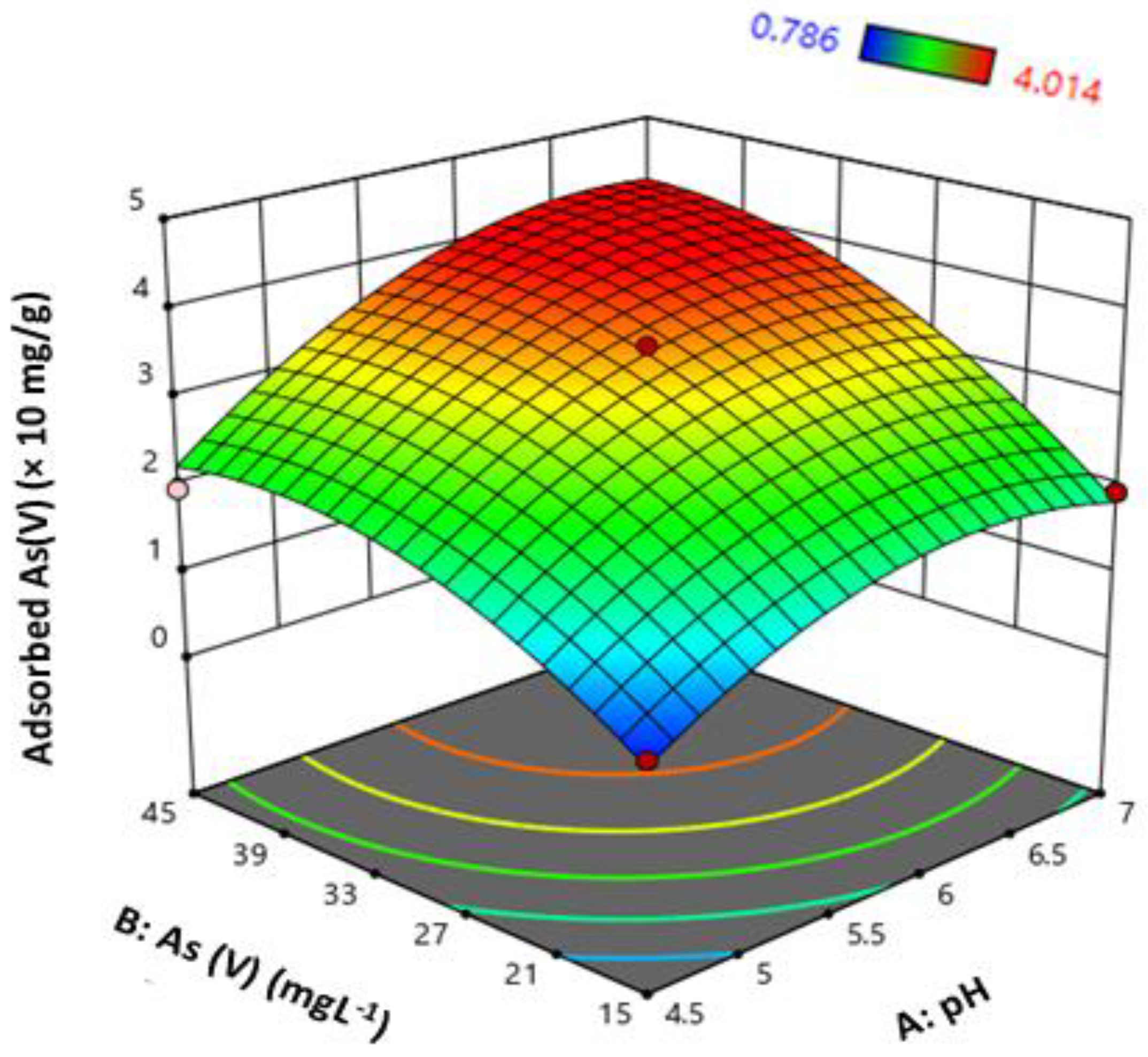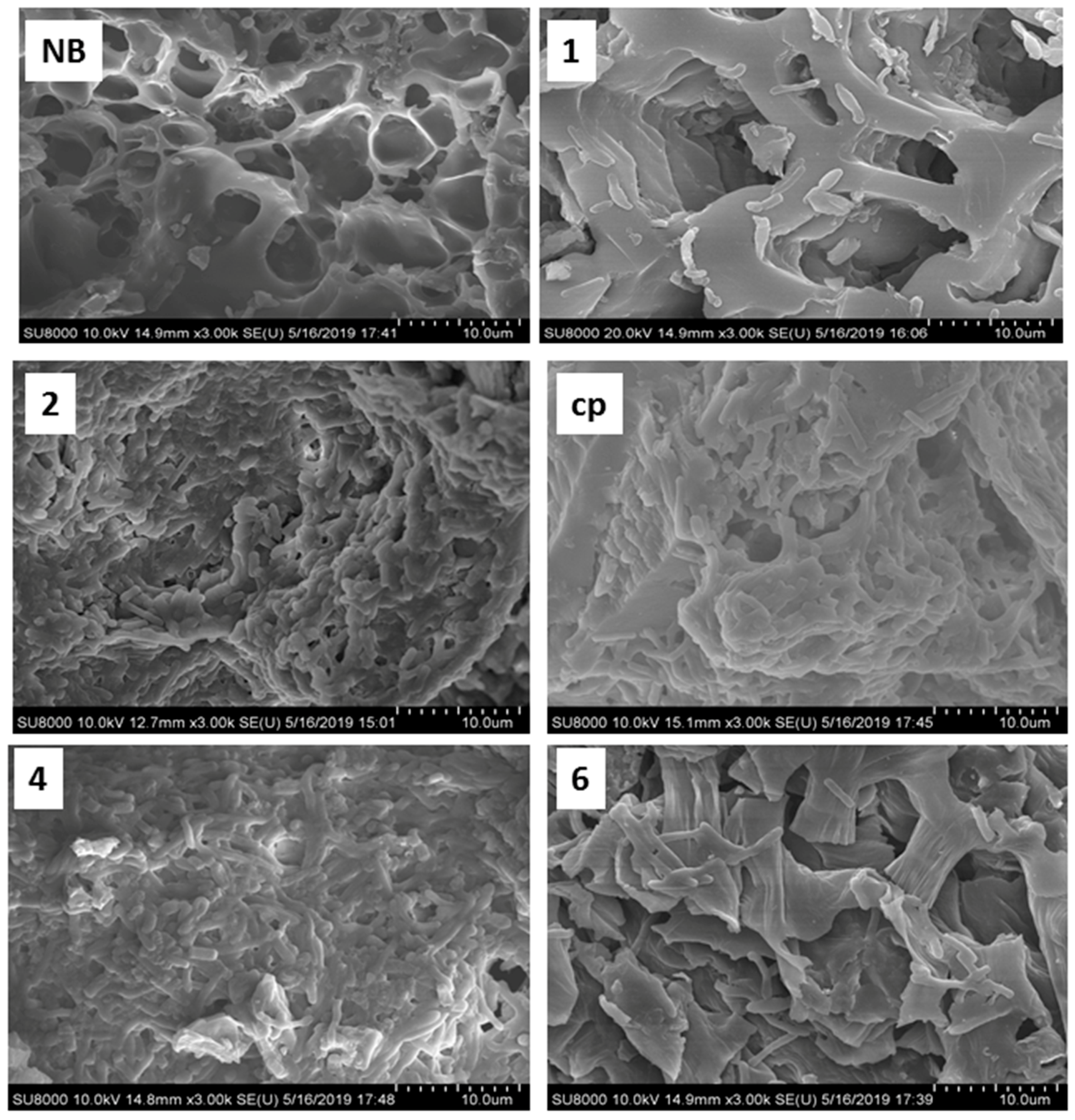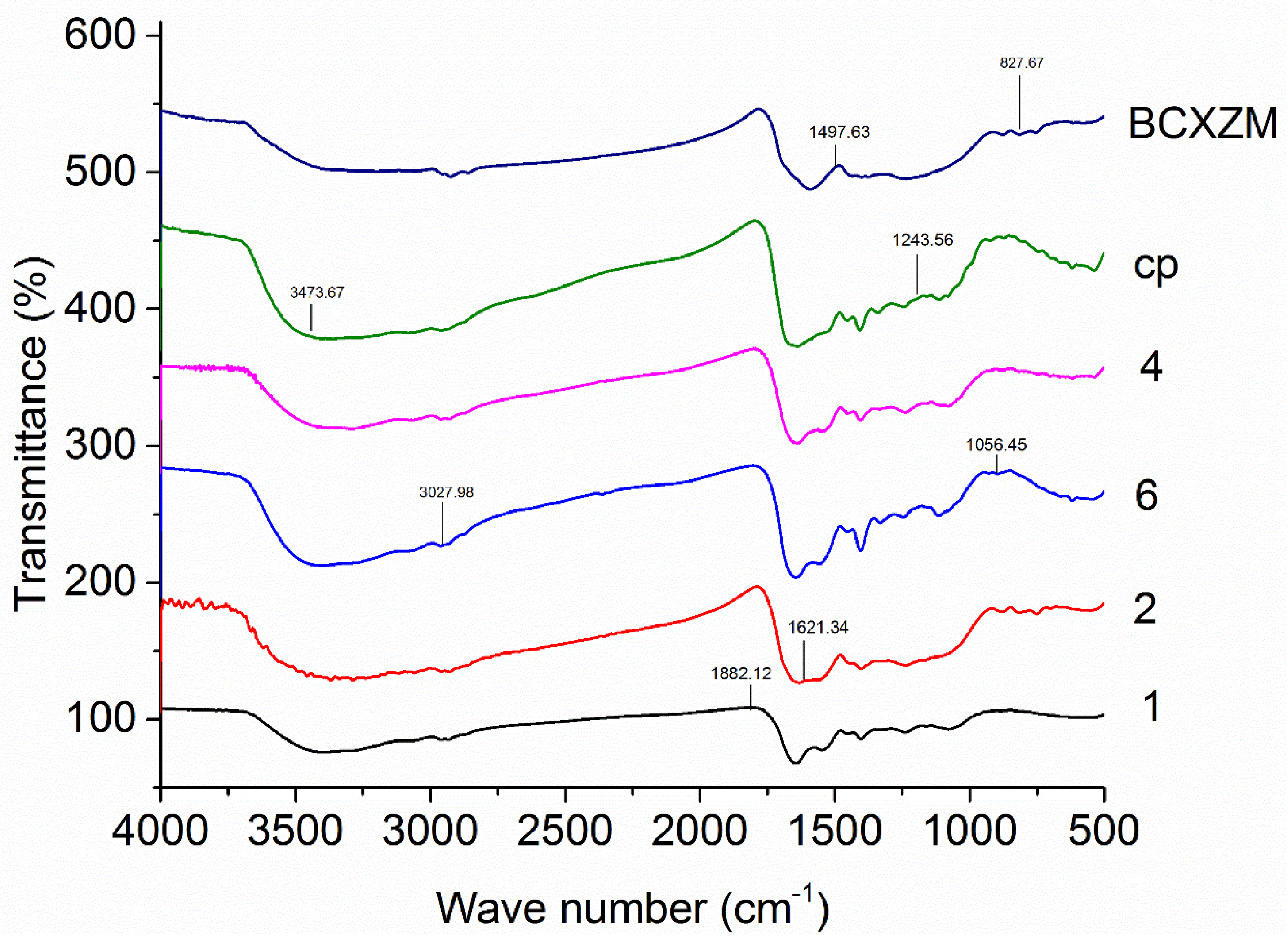Application of BCXZM Composite for Arsenic Removal: EPS Production, Biotransformation and Immobilization of Bacillus XZM on Corn Cobs Biochar
Abstract
:Simple Summary
Abstract
1. Introduction
2. Methodology
2.1. Bacterial Isolation and Identification
2.2. Determination of Extracellular Polymeric Substance (EPS) Production by Bacillus XZM
2.3. Preparation of BCXZM Composite
2.4. Multivariate Optimization
2.5. Experimental Set-Up
2.6. FTIR Spectroscopy
2.7. Scanning Electron Microscopy (SEM) and Energy Dispersive X-ray Spectroscopy
2.8. Arsenic Desorption Assay
2.9. Cost of Making BCXZM Composite
2.10. Statistical Analysis
3. Results and Discussion
3.1. Bacterial Growth, EPS Production and As(V) Reducing Efficiency
3.2. Effect of As(V) Concentration and pH on Arsenic Adsorption by BCXZM Composite
3.3. Optimization and Quadratic Model Equation for Maximum Arsenic Adsorption
3.4. SEM of Bacterial Growth Changes in BCXZM Composite
3.5. EDX Spectroscopy for Maximum Arsenic Adsorption
3.6. FTIR Spectra of BCXZM Composite after Arsenic Adsorption
3.7. Desorption Studies of Arsenic from BCXZM Composite
3.8. Cost of BCXZM Preparation
4. Conclusions
Supplementary Materials
Author Contributions
Funding
Institutional Review Board Statement
Informed Consent Statement
Data Availability Statement
Acknowledgments
Conflicts of Interest
References
- Reis, V.; Duarte, A.C. Occurrence, distribution, and significance of arsenic speciation. Arsen. Speciat. Algae 2019, 85, 1–14. [Google Scholar] [CrossRef]
- Zhang, L.; Qin, X.; Tang, J.; Liu, W.; Yang, H. Review of arsenic geochemical characteristics and its significance on arsenic pollution studies in karst groundwater, Southwest China. Appl. Geochem. 2017, 77, 80–88. [Google Scholar] [CrossRef]
- Uthus, E.O. Arsenic essentiality: A role affecting methionine metabolism. J. Trace Elem. Exp. Med. 2003, 16, 345–355. [Google Scholar] [CrossRef]
- Smedley, P.L.; Kinniburgh, D.G. A review of the source, behaviour and distribution of arsenic in natural waters. Appl. Geochem. 2002, 17, 517–568. [Google Scholar] [CrossRef]
- Fatoki, J.O.; Badmus, J.A. Arsenic as an environmental and human health antagonist: A review of its toxicity and disease initiation. J. Hazard. Mater. Adv. 2022, 5, 100052. [Google Scholar] [CrossRef]
- Andreasen, R.; Li, Y.; Rehman, Y.; Ahmed, M.; Meyer, R.L.; Sabri, A. Prospective role of indigenous Exiguobacterium profundum PT 2 in arsenic biotransformation and biosorption by planktonic cultures and bio-films. J. Appl. Microbiol. 2018, 124, 431–443. [Google Scholar]
- Diba, F.; Khan, M.; Hossain, Z.; Uddin, S.Z.; Istiaq, A.; Shuvo, M.; Rahman, S.; Ul Alam, A.; Hossain, M.A.; Sultana, M.J. Bioaccumulation and detoxification of trivalent arsenic by Achromobacter xylosoxidans BHW-15 and electrochemical detection of its transformation efficiency. Sci. Rep. 2021, 11, 21312. [Google Scholar] [CrossRef]
- Jaafari, J.; Yaghmaeian, K. Optimization of heavy metal biosorption onto freshwater algae (Chlorella coloniales) using response surface methodology (RSM). Chemosphere 2019, 217, 447–455. [Google Scholar] [CrossRef]
- Kazy, S.K.; Sar, P.; Singh, S.; Sen, A.K.; D’Souza, S. Extracellular polysaccharides of a copper-sensitive and a copper-resistant Pseudomonas aeruginosa strain: Synthesis, chemical nature and copper binding. World J. Microbiol. Biotechnol. 2002, 18, 583–588. [Google Scholar] [CrossRef]
- Singh, N.; Gupta, S.; Marwa, N.; Pandey, V.; Verma, P.C.; Rathaur, S.; Singh, N. Arsenic mediated modifications in Bacillus aryabhattai and their biotechnological applications for arsenic bioremediation. Chemosphere 2016, 164, 524–534. [Google Scholar] [CrossRef]
- Ghosh, S.; Mohapatra, B.; Satyanarayana, T.; Sar, P. Molecular and taxonomic characterization of arsenic (As) transforming Bacillus sp. strain IIIJ3–1 isolated from As-contaminated groundwater of Brahmaputra river basin, India. BMC Microbiol. 2020, 20, 256. [Google Scholar] [CrossRef] [PubMed]
- Marwa, N.; Singh, N.; Srivastava, S.; Saxena, G.; Pandey, V.; Singh, N. Characterizing the hyper-tolerance potential of two indigenous bacterial strains (Bacillus flexus and Acinetobacter junii) and their efficacy in arsenic bioremediation. J. Appl. Microbiol. 2019, 126, 1117–1127. [Google Scholar] [CrossRef] [PubMed]
- Vélez, J.M.B.; Martínez, J.G.; Ospina, J.T.; Agudelo, S.O. Bioremediation potential of Pseudomonas genus isolates from residual water, capable of tolerating lead through mechanisms of exopolysaccharide production and biosorption. Biotechnol. Rep. 2021, 32, e00685. [Google Scholar] [CrossRef] [PubMed]
- Zannier, F.; Portero, L.R.; Ordoñez, O.F.; Martinez, L.J.; Farias, M.E.; Albarracin, V.H. Polyextremophilic bacteria from high altitude Andean Lakes: Arsenic resistance profiles and biofilm production. BioMed Res. Int. 2019, 2019, 1231975. [Google Scholar] [CrossRef]
- Jebelli, M.A.; Maleki, A.; Amoozegar, M.A.; Kalantar, E.; Gharibi, F.; Darvish, N.; Tashayoe, H. Isolation and identification of the native population bacteria for bioremediation of high levels of arsenic from water re-sources. J. Environ. Manag. 2018, 212, 39–45. [Google Scholar] [CrossRef]
- Yang, Z.; Wu, Z.; Liao, Y.; Liao, Q.; Yang, W.; Chai, L. Combination of microbial oxidation and biogenic schwertmannite immobilization: A potential remediation for highly arsenic-contaminated soil. Chemosphere 2017, 181, 1–8. [Google Scholar] [CrossRef]
- Al-Amshawee, S.; Yunus, M.Y.B.M.; Vo, D.-V.N.; Tran, N.H. Biocarriers for biofilm immobilization in wastewater treatments: A review. Environ. Chem. Lett. 2020, 18, 1925–1945. [Google Scholar] [CrossRef]
- Podder, M.; Majumder, C. Predictive approach for simultaneous biosorption and bioaccumulation of arsenic by Corynebacterium glutamicum MTCC 2745 biofilm supported on NL/MnFe2O4 composite. J. Water Process Eng. 2016, 11, 8–31. [Google Scholar] [CrossRef]
- Deng, M.; Li, K.; Yan, Y.-J.; Huang, F.; Peng, D. Enhanced cadmium removal by growing Bacillus cereus RC-1 immobilized on different magnetic biochars through simultaneous adsorption and bio-accumulation. Environ. Sci. Pollut. Res. Int. 2022, 29, 18495–18507. [Google Scholar] [CrossRef]
- Podder, M.; Majumder, C. Fixed-bed column study for As (III) and As (V) removal and recovery by bacterial cells immobilized on Sawdust/MnFe2O4 composite. Biochem. Eng. J. 2016, 105, 114–135. [Google Scholar] [CrossRef]
- Zhu, N.; Zhang, J.; Tang, J.; Zhu, Y.; Wu, Y. Arsenic removal by periphytic biofilm and its application combined with biochar. Bioresour. Technol. 2018, 248, 49–55. [Google Scholar] [CrossRef] [PubMed]
- Podder, M.; Majumder, C. Sequestering of As (III) and As (V) from wastewater using a novel neem leaves/MnFe2O4 composite biosorbent. Int. J. Phytoremediation 2016, 18, 1237–1257. [Google Scholar] [CrossRef] [PubMed]
- Jang, H.M.; Yoo, S.; Choi, Y.-K.; Park, S.; Kan, E. Adsorption isotherm, kinetic modeling and mechanism of tetracycline on Pinus taeda-derived activated biochar. Bioresour. Technol. 2018, 259, 24–31. [Google Scholar] [CrossRef] [PubMed]
- Saba; Rehman, Y.; Ahmed, M.; Sabri, A.N. Potential role of bacterial extracellular polymeric substances as biosorbent material for arsenic bioremediation. Bioremediation J. 2019, 23, 72–81. [Google Scholar] [CrossRef]
- Singh, N.; Balomajumder, C. Simultaneous biosorption and bioaccumulation of phenol and cyanide using coconut shell activated carbon immobilized Pseudomonas putida (MTCC 1194). J. Environ. Chem. Eng. 2016, 4, 1604–1614. [Google Scholar] [CrossRef]
- Bangaraiah, P.; Babu, B.S.; Peele, K.A.; Reddy, E.R.; Venkateswarulu, T.C. Removal of multiple metals using Tamarindus indica as biosorbent through optimization of process variables: A statistical approach. Int. J. Environ. Sci. Technol. 2020, 17, 1835–1846. [Google Scholar] [CrossRef]
- Khan, S.U.; Mahtab, M.S.; Farooqi, I.H. Enhanced lead (II) removal with low energy consumption in an electrocoagulation column employing concentric electrodes: Process optimisation by RSM using CCD. Int. J. Environ. Anal. Chem. 2021, 1–18. [Google Scholar] [CrossRef]
- Vieira, J.; Soares, L.; Froes-Silva, R. Comparing chemometric and Langmuir isotherm for determination of maximum capacity adsorption of arsenic by a biosorbent. Microchem. J. 2018, 137, 324–328. [Google Scholar] [CrossRef]
- Xie, Z.; Sun, X.; Wang, Y.; Luo, Y.; Xie, X.; Su, C. Response of growth and superoxide dismutase to enhanced arsenic in two Bacillus species. Ecotoxicology 2014, 23, 1922–1929. [Google Scholar] [CrossRef]
- Faheem, F.; Bao, J.; Zheng, H.; Tufail, H.; Irshad, S.; Du, J. Adsorption-assisted decontamination of Hg (ii) from aqueous solution by multi-functionalized corncob-derived biochar. RSC Adv. 2018, 8, 38425–38435. [Google Scholar] [CrossRef]
- Podder, M.; Majumder, C. Study of the kinetics of arsenic removal from wastewater using Bacillus arsenicus biofilms supported on a Neem leaves/MnFe2O4 composite. Ecol. Eng. 2016, 88, 195–216. [Google Scholar] [CrossRef]
- Yrjälä, K.; Ramakrishnan, M.; Salo, E. Agricultural waste streams as resource in circular economy for biochar production towards carbon neutrality. Curr. Opin. Environ. Sci. Health 2022, 26, 100339. [Google Scholar] [CrossRef]
- Wu, C.; Chen, Y.; Qian, Z.; Chen, H.; Li, W.; Li, Q.; Xue, S. The effect of extracellular polymeric sub-stances (EPS) of iron-oxidizing bacteria (Ochrobactrum EEELCW01) on mineral transformation and arsenic (As) fate. J. Environ. Sci. 2023, 130, 187–196. [Google Scholar] [CrossRef] [PubMed]
- Kang, A.J.; Munz, G.; Yuan, Q. Influence of pH control on material characteristics, bacterial community composition and BNR performance of mature aerobic granules. Process Saf. Environ. Prot. 2019, 124, 158–166. [Google Scholar] [CrossRef]
- Alkhatib, M.F.; Mamun, A.A.; Akbar, I. Application of response surface methodology (RSM) for optimization of color removal from POME by granular activated carbon. Int. J. Environ. Sci. Technol. 2014, 12, 1295–1302. [Google Scholar] [CrossRef]
- Banerjee, A.; Sarkar, P.; Banerjee, S. Application of statistical design of experiments for optimization of As(V) biosorption by immobilized bacterial biomass. Ecol. Eng. 2016, 86, 13–23. [Google Scholar] [CrossRef]
- Mohebbrad, B.; Bonyadi, Z.; Dehghan, A.A.; Rahmat, M.H. Arsenic removal from aqueous solutions using Saccharomyces cerevisiae: Kinetic and equilibrium study. Environ. Prog. Sustain. Energy 2018, 38, S398–S402. [Google Scholar] [CrossRef]
- Xu, T.; Stubbs, J.E.; Eng, P.J.; Catalano, J.G. Response of interfacial water to arsenate adsorption on corun-dum (0 0 1) surfaces: Effects of pH and adsorbate surface coverage. Geochim. Cosmochim. Acta 2018, 239, 198–212. [Google Scholar] [CrossRef]
- Kleanthous, C. Compartmentalizing acid stress in bacteria. Nat. Chem. Biol. 2018, 14, 993. [Google Scholar] [CrossRef]
- Nascimento, V.; França, C.; Hernández-Montelongo, J.; Machado, D.; Lancellotti, M.; Cotta, M.; Landers, R.; Beppu, M. Influence of pH and ionic strength on the antibacterial effect of hyaluronic acid/chitosan films assembled layer-by-layer. Eur. Polym. J. 2018, 109, 198–205. [Google Scholar] [CrossRef]
- Dey, U.; Chatterjee, S.; Mondal, N.K. Isolation and characterization of arsenic-resistant bacteria and possible application in bioremediation. Biotechnol. Rep. 2016, 10, 1–7. [Google Scholar] [CrossRef] [PubMed]
- Tabaraki, R.; Heidarizadi, E. Simultaneous biosorption of Arsenic (III) and Arsenic (V): Application of multiple response optimizations. Ecotoxicol. Environ. Saf. 2018, 166, 35–41. [Google Scholar] [CrossRef] [PubMed]
- Zhang, W.; Zhang, G.; Liu, C.; Li, J.; Zheng, T.; Ma, J.; Wang, L.; Jiang, J.; Zhai, X. Enhanced removal of arsenite and arsenate by a multifunctional Fe-Ti-Mn composite oxide: Photooxidation, oxidation and adsorption. Water Res. 2018, 147, 264–275. [Google Scholar] [CrossRef] [PubMed]
- Podder, M.; Majumder, C. Simultaneous biosorption and bioaccumulation: A novel technique for the efficient removal of arsenic. Sustain. Water Resour. Manag. 2017, 3, 357–389. [Google Scholar] [CrossRef]
- Libatique, M.J.H.; Lee, M.-C.; Yeh, H.-Y.; Jhang, F.-J. Total and inorganic arsenic biosorption by Sarcodia suiae (Rhodophyta), as affected by controlled environmental conditions. Chemosphere 2020, 248, 126084. [Google Scholar] [CrossRef]
- Batista, E.M.; Shultz, J.; Matos, T.T.; Fornari, M.R.; Ferreira, T.M.; Szpoganicz, B.; de Freitas, R.A.; Mangrich, A.S. Effect of surface and porosity of biochar on water holding capacity aiming indirectly at preservation of the Amazon biome. Sci. Rep. 2018, 8, 10677. [Google Scholar] [CrossRef]
- Sorg, T.J.; Wang, L.; Chen, A.S. Technology—AQUA. The costs of small drinking water systems removing arsenic from groundwater. J. Water Supply Res. Technol. 2014, 64, 219–234. [Google Scholar] [CrossRef]
- Bhakta, J.N.; Ali, M.M. Biosorption of arsenic: An emerging eco-technology of arsenic detoxification in drinking water. In Arsenic Water Resources Contamination; Springer: Berlin/Heidelberg, Germany, 2020. [Google Scholar] [CrossRef]







| Experiment | pH | As(V) (mg·L−1) | q (×10 mg/g) |
|---|---|---|---|
| 1 | 4.5 | 15.00 | 0.86 ± 1.23 |
| 2 | 7.00 | 15.00 | 1.93 ± 1.16 |
| 3 | 4.50 | 45.00 | 1.96 ± 0.97 |
| 4 | 7.00 | 45.00 | 4.01 ± 1.31 |
| 5 | 3.98 | 30.00 | 1.25 ± 0.78 |
| 6 | 7.51 | 30.00 | 3.34 ± 0.85 |
| 7 | 5.75 | 8.78 | 0.78 ± 1.58 |
| 8 | 5.75 | 51.21 | 3.99 ± 1.02 |
| 9 (cp *) | 5.75 | 30.00 | 3.46 ± 1.30 |
| 10 (cp) | 5.75 | 30.00 | 3.59 ± 0.99 |
| 11 (cp) | 5.75 | 30.00 | 3.46 ± 1.08 |
| Source | Sum of Squares | df | Mean Square | F-Value | p-Value * | |
|---|---|---|---|---|---|---|
| Model | 15.6 | 5 | 3.13 | 53.48 | 0.0002 | Significant |
| A-pH | 4.62 | 1 | 4.62 | 78.80 | 0.0003 | |
| B-As(V) | 7.45 | 1 | 7.45 | 127.20 | <0.0001 | |
| AB | 0.24 | 1 | 0.24 | 4.15 | 0.0673 | |
| A2 | 2.33 | 1 | 2.33 | 39.76 | 0.0015 | |
| B2 | 2.01 | 1 | 2.01 | 34.27 | 0.0021 | |
| Residual | 0.29 | 5 | 0.058 | |||
| Lack of Fit | 0.281 | 3 | 0.0937 | 15.64 | 0.0507 | not significant |
| Pure Error | 0.012 | 2 | 0.006 | |||
| Cor Total | 15.9 | 10 |
| Amount Required | Cost (USD) | |
|---|---|---|
| Biochar | 5.75 g | 0.05 |
| Bacterial biofilm formation (electricity kw) | 7.608 | 0.699 |
| Peptone | 35.9375 g | 17.32 |
| Beef extract | 14.375 g | 6.21 |
| NaCl | 35.935 g | 5.66 |
| Deionized water for biofilm preparation | 7.187 L | 2.355 |
| Electricity for arsenic removal (kw) | 7.608 | 0.699 |
| Total cost of BCXZM preparation for 1 g of As(V) adsorption | 32.993 | |
| If the As concentration in drinking water is considered as 50 µg/L [47] | ||
| Volume of water with 1 g of arsenic (Gallons) | 5283.441 | |
| BCXZM cost for 5283.441 gallons (USD) | 32.993 | |
| BCXZM cost per gallon (USD) | 0.006244 | |
| BCXZM cost per 1000 gallon (USD) | 6.24460 | |
Disclaimer/Publisher’s Note: The statements, opinions and data contained in all publications are solely those of the individual author(s) and contributor(s) and not of MDPI and/or the editor(s). MDPI and/or the editor(s) disclaim responsibility for any injury to people or property resulting from any ideas, methods, instructions or products referred to in the content. |
© 2023 by the authors. Licensee MDPI, Basel, Switzerland. This article is an open access article distributed under the terms and conditions of the Creative Commons Attribution (CC BY) license (https://creativecommons.org/licenses/by/4.0/).
Share and Cite
Irshad, S.; Xie, Z.; Qing, M.; Nawaz, A.; Mehmood, S.; Alomar, S.Y.; Faheem, M.; Walayat, N. Application of BCXZM Composite for Arsenic Removal: EPS Production, Biotransformation and Immobilization of Bacillus XZM on Corn Cobs Biochar. Biology 2023, 12, 611. https://doi.org/10.3390/biology12040611
Irshad S, Xie Z, Qing M, Nawaz A, Mehmood S, Alomar SY, Faheem M, Walayat N. Application of BCXZM Composite for Arsenic Removal: EPS Production, Biotransformation and Immobilization of Bacillus XZM on Corn Cobs Biochar. Biology. 2023; 12(4):611. https://doi.org/10.3390/biology12040611
Chicago/Turabian StyleIrshad, Sana, Zuoming Xie, Mao Qing, Asad Nawaz, Sajid Mehmood, Suliman Yousef Alomar, Muhammad Faheem, and Noman Walayat. 2023. "Application of BCXZM Composite for Arsenic Removal: EPS Production, Biotransformation and Immobilization of Bacillus XZM on Corn Cobs Biochar" Biology 12, no. 4: 611. https://doi.org/10.3390/biology12040611
APA StyleIrshad, S., Xie, Z., Qing, M., Nawaz, A., Mehmood, S., Alomar, S. Y., Faheem, M., & Walayat, N. (2023). Application of BCXZM Composite for Arsenic Removal: EPS Production, Biotransformation and Immobilization of Bacillus XZM on Corn Cobs Biochar. Biology, 12(4), 611. https://doi.org/10.3390/biology12040611










